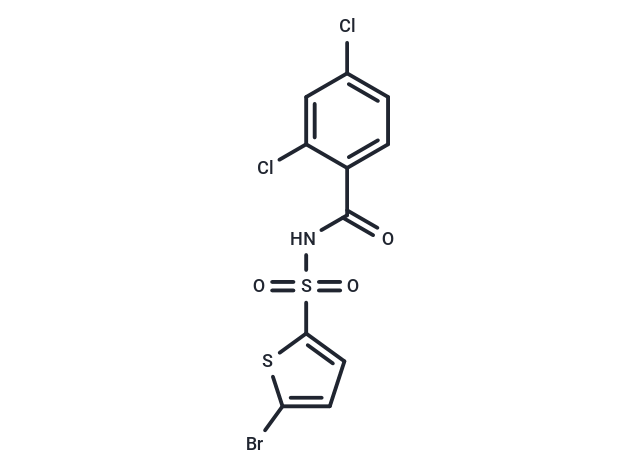Shopping Cart
- Remove All
 Your shopping cart is currently empty
Your shopping cart is currently empty

Tasisulam (LY573636) is an apoptosis inducer and an antitumor agent via the intrinsic pathway.

| Pack Size | Price | Availability | Quantity |
|---|---|---|---|
| 5 mg | $35 | In Stock | |
| 10 mg | $56 | In Stock | |
| 25 mg | $126 | In Stock | |
| 50 mg | $215 | In Stock | |
| 100 mg | $322 | In Stock | |
| 200 mg | $483 | In Stock | |
| 500 mg | $789 | In Stock | |
| 1 mL x 10 mM (in DMSO) | $54 | In Stock |
| Description | Tasisulam (LY573636) is an apoptosis inducer and an antitumor agent via the intrinsic pathway. |
| In vitro | Tasisulam inhibits growth of various human leukemia and lymphoma cell lines with ED50 ranging from 7 to 40 μM. LY573636 also induces apoptosis in HL60, Reh, and MD901 cells, mainly by loss of mitochondrial membrane potential and induction of reactive oxygen species. [1] In addition, Tasisulam also produce antiproliferative activities in more than 70% of the 120 cell lines tested with EC50 of less than 50 μM. Tasisulam induces G2–M accumulation and subsequent apoptosis in Calu-6 and A-375 cells. In vitro, Tasisulam also inhibits VEGF-, FGF- and EGF-induced endothelial cord formation with EC50 of 47, 103, and 34 nM, respectively. [2] |
| In vivo | Tasisulam induces morphologic features of vascular normalization, including increased pericyte coverage and decreased hypoxia in vivo. Tasisulam (25 or 50 mg/kg, i.v.) displays dose-dependent antitumor activity, induces apoptosis, and normalizes tumor-associated vasculature in the Calu-6 non–small cell lung xenograft model. Besides, Tasisulam displays potent antitumor activity across a range of in vivo xenografts, including colorectal (HCT-116), melanoma (A-375), gastric (NUGC-3), leukemia (MV-4-11), and pancreatic (QGP-1). [2] |
| Kinase Assay | Electrophysiology: The human IKCa1 is cloned and expressed in COS-7 cells. Cells are studied in the whole-cell configuration of the patch-clamp technique. The holding potential is 280 mV. The internal pipette solution contains: 145 mM K+ aspartate, 2 mM MgCl2, 10 mM Hepes, 10 mM K2EGTA, and 8.5 mM CaCl2 (1 μM free Ca2+), pH 7.2, 290-310 mOsm. To reduce currents from the native chloride channels in COS-7 cells, Na+ aspartate Ringer is used as an external solution: 160 mM Na+ aspartatey/4.5 mM KCl/2 mM CaCl2/1 mM MgCl2/5 mM Hepes, pH 7.4/290-310 mOsm. IKCa currents in COS-7 cells are elicited by 200-ms voltage ramps from -120 mV to 40 mV applied every 10 seconds and the reduction of slope conductance at -80 mV by TRAM-34 taken as a measure of channel block. |
| Cell Research | Cells are treated with various concentrations of LY573636. 3-(4,5-Dimethylthiazol-2-yl)-2,5-diphenyltetrazolium bromide (MTT) assay is performed. Briefly, MTT is dissolved in phosphate-buffered saline (PBS) at 5 mg/mL. Approximately 1,000 cells per well are incubated in culture medium for 96 hours in 96-well plates; and then, 10 μL of the MTT solution is added. After a 4-hour incubation, 100 μL of solubilization solution (20 % sodium dodecyl sulfate [SDS]) is added, and the mixture was incubated at 37 °C for 16 hours. In this assay, MTT is cleaved to an orange formazan dye by metabolically active cells; and the absorbance of the formazan product is measured with an enzyme-linked immunoabsorbent assay (ELISA) reader at 540 nm. (Only for Reference) |
| Alias | LY573636 |
| Molecular Weight | 415.11 |
| Formula | C11H6BrCl2NO3S2 |
| Cas No. | 519055-62-0 |
| Smiles | Clc1ccc(C(=O)NS(=O)(=O)c2ccc(Br)s2)c(Cl)c1 |
| Relative Density. | 1.812 |
| Storage | Powder: -20°C for 3 years | In solvent: -80°C for 1 year | Shipping with blue ice. | |||||||||||||||||||||||||||||||||||
| Solubility Information | Ethanol: 77 mg/mL (185.49 mM), Sonication is recommended. DMSO: 77 mg/mL (185.49 mM), Sonication is recommended. H2O: < 1 mg/mL (insoluble or slightly soluble) | |||||||||||||||||||||||||||||||||||
Solution Preparation Table | ||||||||||||||||||||||||||||||||||||
Ethanol/DMSO
| ||||||||||||||||||||||||||||||||||||

Copyright © 2015-2025 TargetMol Chemicals Inc. All Rights Reserved.